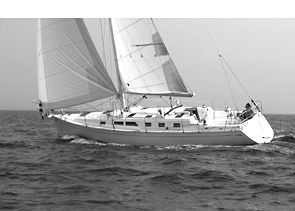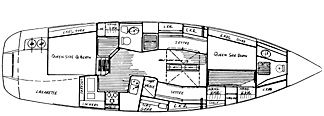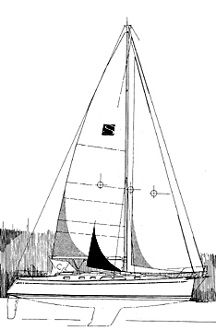The term “performance cruiser” has become so overused by production builders as to have lost much of its meaning. We think the definition includes (but is not limited to) boats that can be sailed to their potential by two people, or even a singlehander. Cockpits should be large enough for comfortable lounging in warm climes, or under the moon. Each space belowdecks should be large enough for its intended use. And pricing should correspond to value.
The Robert Perry-designed Saga 43 seems to fit most of those definitions.
Company History
Saga Yachts, Inc., of Ontario, Canada, was formed in 1995 by Allan Poole and three business partners. The firm commissioned Robert H. Perry to design the first Saga yacht, the 43-footer of which we speak, which began rolling off the production line in 1996. The company’s plan was to build performance cruisers suitable for bluewater sailing that are of higher quality than mainstream production builders.

A Scot, with an engineering degree from Strathclyde University in Glascow, Poole built race-winning performance sailing yachts for 10 years prior to emigrating to Canada. He held positions as general manager for CS Yachts, director of marketing for Tartan Yachts, and was president of Hinterholler Yachts. Immediately prior to forming Saga, he worked for C&C Yachts before it ceased operations.
The partnership at Saga, however, was not a happy one, and was terminated in 1998. Poole subsequently purchased the molds, and reorganized the company as Saga Marine. It now employs 35 people in a 20,000-square foot facility, and produces 12 to 15 boats annually. In addition to the 43-footer, the company manufacturers a Perry designed 35-footer. Perry is currently designing a 47-footer that the company plans to debut in 2002.
Dealers are located in Annapolis, Connecticut, Seattle, and California.
The Design
Seattle architect Perry’s designs occupy a wide swath of the sailboat horizon. Three decades after its introduction, his Valiant 40 is still considered a well-mannered bluewater cruiser. Other designs include the Nordic 40 and the Esprit 37.
From the outset, the Saga 43 was “designed to be a legitimate fast cruiser that would combine elements from racing trends with a long waterline that increases speed and interior volume,” says Perry. “Most cruisers are designed inside out, but not here. We wanted to appeal to an owner who knows performance. Allan and I started with a big cockpit that would be comfortable and ease the task of managing the boat. We wanted a better balance between spaces on deck and below.”
The boat has a fine entry, with beam carried well forward. “She’s not narrow, says Perry, “though she’s six inches narrower than the Valiant 40. She’s just not fat. I think the marketplace is inundated with fat boats.”
There’s not much flare in the hull, but she provides a dry ride, as we learned on our test sail. There’s a bit of hollow at her bow, and she has a relatively low, 19″ high coachroof. Of her profile, Perry says, “I like a strong spring to the sheer.”
Her length-to-beam ratio is 3.94. Perry considers a narrow hull one with a ratio over 4.0, and anything under 3.2 fat.
“She’s complex forward but a normal design aft,” Perry says. At the opposite end of her fine entry, she presents a stout, stable section at the stern. “We wanted good tracking,” says Perry. “The hull form and rig combine to provide a neutral helm under most conditions.
“Most cruisers reef as a survival move, while racers reef to improve performance. You don’t have to wait until this boat is out of control to reef—she lets you know.”
Three keels are available, including a recently introduced shoal-draft version with a bulb and longer chord length to improve lift. The partially balanced spade rudder was placed as far aft as possible, allowing easier steering under a spinnaker in heavy seas.
Both of the oft-used ratios that measure performance potential indicate that she is a goer. The SA/D is 19.09 with a self-tacking jib, which places her on the high end of the “performance cruiser” scale, and a D/L of 152—lower than the typical production cruiser. Her polar plots indicate she’ll be fastest sailing between 120 and 135 degrees, when speed will reach 10 knots in 20 knots of wind. On paper she should sail to weather in the same wind at 7-plus knots.
Deck Layout
Perhaps the most noteworthy characteristic of the rig and deck layout is that they were conceived with an eye to simplified shorthanded sailing at speed in the ocean. She carries a masthead rig with double headstays, like many round-the- world racers. Both headsails are flown from Harken furlers. The jib headstay is tacked at the stem. The stay for overlapping headsails is 2.6 feet forward at the end of the stainless steel bowsprit.
The inner jib is self-tacking, secured to a Harken traveler on the cabintop forward. The idea is that this jib will do for windward work, while off the wind the high-clewed outer jib will be unrolled and the inner jib furled. This set-up is somewhat ostentatiously called a Variable Geometry Rig™. The only real criticism we have of the system is that the short distance between stays requires manhandling the outer jib through the slot in a tack or a jibe (they do happen) and will produce excessive wear on the sail and the foredeck crew in any amount of air. It will be less of a problem for offshore sailors, who sometimes don’t change course for days.
The keel-stepped Offshore mast is supported by 1×19 wire. Shrouds are continuous. There are two sets of spreaders, swept slightly aft. The solid Forespar vang carries a 16:1 block and tackle.
What the casual observer would consider minor touches attest to her intended use: Decks are 19″ wide and chainplates are at the base of the cabin, so movement is unimpeded. Lifelines are 30″ tall—our preference for blue-water boats and 4-6″ higher than those of many competitors. On the port side of the mast is a compartment, flush to the deck, for storage of halyard tails and winch handles. Safety rails at the mast are standard, as are padeyes for jacklines. Also standard on newer boats is a spare main halyard and a storm trysail track on the mast.
The bowsprit has double rollers, and the anchor locker is divided into two compartments large enough for storage of 300 feet of rode.
Spaces belowdecks are well-lit and well-ventilated. Two Lewmar Ocean Series hatches are on the bow, three more are on the coachroof, and eight stainless-steel framed ports and four fixed portlights add illumination. There are four Dorade boxes with stainless steel cowls.

The builder succeeded in producing a cockpit with seats long enough for lounging. This cockpit is 79″ on the centerline forward of the wheel, and the footwell is 42″ wide. Seats are 7’6″ long, and 19″ wide, so a crew of eight can sit comfortably. The nonskid is “leather grained”— not the typical diamond pattern. It seems to provide good grip.
Primary winches on our test boat, hull #16, were Harken 56 self-tailers. Hoisting the mainsail, which is outfitted with a Harken Batt-Car system, is a matter of pressing a button that energizes the electric Harken 40 self-tailer on the cabintop. The mainsheet is housed on a traveler forward of the companionway, and, like the sheet for the self-tacking jib, is led to a winch at the companionway. Halyard tails and reefing lines can be tucked out of sight in cubbies in the coaming.
The wheel is a 40″ Edson stainless steel destroyer type that allowed two-finger steering during our test sail. A molded foot brace in the cockpit sole provided good support when steering while heeled 15-20°.
In addition to room for crew in the cockpit, there’s also a cavernous locker to starboard. The space is 51” deep and allows for storage of an inflatable dinghy and oars below spare sails, cleaning supplies, and fenders. A separate liferaft compartment is aft to starboard, as is a locker designed to house a 6-gallon gasoline tank for an outboard motor. Two 5-lb propane bottles live in a locker in the port corner.
Belowdecks
The first impression upon stepping below is of spaciousness created by 6’5″ headroom, ample clearance amidships between settees, and light reflecting off hand-rubbed cherry and a white liner. The cabin sole is 1″ thick, with teak and holly veneer. The saloon measures 14′ on the centerline.
The common denominators of the three available interior layouts are galley and nav station to starboard, head and dining area to port.
The C-shaped galley is large enough for a chef and helper. The Corian countertop is 39″ wide and 21″ deep, with refrigerator and freezer located at the aft end below a cabinet designed to house a microwave. Standard equipment is a gimbaled three-burner Force 10 stove with oven. The owner told us that storage cabinets surrounding the space were adequate for a crew of three on a 19-day passage from Hawaii to San Francisco. The space is well ventilated by two opening ports.
The navigator sits on the settee and faces aft at a table measuring 36″ wide and 24″ deep—large enough to spread out a big section of chart.
The wiring behind the electric panel is excellent; removing two wing nuts allows the panel to swing down, providing instant access to wiring that is color coded, nicely bundled, and protected by Plexiglas boxes.
Though it sits in the center of the area, the 48″ long dining table is narrow enough with leaves down that it does not interfere with traffic forward, or access to settees. With leaves up, it is 54″ wide, adequate for seating four. Settees are 78″ long, and designed to convert to sea-berths.
Our test boat was equipped with a single head compartment, which was large enough to allow movement without banging into the bulkheads. Headroom is 6′ 2″. The space is surrounded by a seamless, molded pan nearly devoid of wood trim or grates that become greenhouses for mildew. A 16″ wide vanity and sink, mirror, storage cabinets, and toothbrush/cup holder are molded in the pan. Standing room in the shower is 26″ square, with an additional 13″ on a seat. The space is enclosed by a curved Plexiglas door that protects the main compartment from splashing water.

The boat was introduced with fore and aft staterooms and a second head in the bow. Beginning with hull #16, the forward head was eliminated. The most recent option is a queen-sized berth on an island on the centerline in the bow (not a good sea-berth, and not even good for sleeping in a rough harbor), with an optional head or closet.
Accommodations in the forward stateroom on our test boat included a queen-sized Pullman berth to port—far preferable for offshore sailing. There’s generous storage space in six pull-out drawers, a compartment outboard under the berth, and three cabinets on the hull, one with a 24″ wide hanging locker.
In the single-head configuration, the space forward of the stateroom is a 4’4″ x 5′ compartment that could be used as a workbench area (!) or extra storage area.
The berth in the aft stateroom is 80″ long and 72″ wide, and covered with 4″ thick cushions. Also in the cabin are a hanging locker and four large drawers—enough space for four sets of foulies and a moderate wardrobe. Spaces below the berth are occupied by batteries.
Aluminum tanks store diesel amidships on the centerline, and water port and starboard under the settees, and under the Pullman berth.
Construction
Saga’s construction techniques reflect standard methods employed by the better builders in the industry. Hulls are sprayed with two layers of ISO-NPG gelcoat. The laminate is hand-laid and squeegeed to eliminate excess resin in the lamination. Two layers of vinylester resin are in the skin coat; polyester resins are in other layers.
The hull is cored with 3/4″ Baltek AL600 balsa sandwiched by four layers of chop and 2408 biaxial stitch mat on the exterior, and two layers on the interior. The 1-3/4″ thick bottom is solid fiberglass; additional reinforcing is on the centerline, at the keel, rudder, and mast step. The layup schedule for the deck is essentially the same, with core removed andsolid fiberglass reinforcements added in areas where hardware will be installed. Deck hardware is installed with aluminum backing plates.
Support for the hull is produced by an 18″ deep matrix frame constructed of 6 layers of 2408 mat, all of which are bonded to the hull, as are bulkheads and cabinetry. (These last are also bonded to the deck “where appropriate.”)
The hull-deck joint is a flange bonded with 3M 5200 and fasteners located on 4″ centers. Similarly, the aluminum toerail is bonded with 3M 5200 and through-bolted with aluminum washers and nuts.
The keel is cast lead, secured to the hull with two rows of 1″ keel bolts. The rudder stock is 2″ diameter stainless steel.
The mast and chainplates are grounded with 7AG copper wire for lightening protection. Seacocks are Marelon ball valves, and hoses are fitted with double clamps.
Performance
We sailed hull #16 on San Francisco bay with Dwight Odom, a recent competitor in the Singlehanded Transpac, a 2,120-mile voyage from San Francisco to Hawaii. Though fit, Odom is in his 60s. This certainly speaks to the ease with which this 43- footer can be sailed.
Odom recorded boatspeeds of 14 knots sailing downwind in 35-40 knots of wind, flying a headsail and reefed main. We didn’t experience those conditions on our test sail.
She was not lightened for the test sail. We pulled away from the slip carrying a stainless steel wind vane on the stern, 300 feet of chain in the bow, provisions, and clothing.
Flying a full mainsail and 110% jib, and sailing as high on the breeze as possible without stalling the jib, speed reached 5.5 knots in 12 knots of true wind. When the wind freshened to 14-16 knots, our speed over the ground increased to 6.6 knots while sailing into a flooding tide under the Golden Gate Bridge. She was heeled 15-20 degrees, the helm was light, and she was in a comfortable groove.
Easing sheets and sailing between a close reach and a beam reach in 12 knots of true wind, the GPS recorded 8 knots, a half-knot faster than her polars indicate. As the breeze lightened we footed off to a broad reach and speed fluctuated between 7.9-8.2 knots. (This was now with a bit of current behind us.)
She also motors comfortably at 7-8 knots, though one owner claims to have pegged the speedo at 9 knots. Her standard engine is a 56- hp Yanmar fitted with a three bladed prop. A feathering prop will be important for the performance sailor.
One owner who kept close records of fuel consumption on a passage from the British Virgin Islands to the East Coast traveled at 8.2 knots at 3100 rpm, and 9 knots at 3600 rpm, with fuel consumption of about one gallon per hour.
Conclusions
This boat was designed for serious sailors interested in maximizing performance and cruising in comfort. She’s faster than most production boats her size. The cockpit is large, and spaces below reflect Bob Perry’s ability to design comfortable accommodations.
The company’s warranty is fairly typical of the industry. It covers any defective workmanship and/or materials for a period of a year. Exceptions to this are a 5-year limited warranty on the hull structure, and 10-year limited warranty on gelcoat blistering and osmosis. The warranty is transferable to a second owner.
The boat was introduced with a $226,000 price tag, and owners have been rewarded with increases in resale value. Two used boats in the northeast recently sold for $299,000 and $295,000.
Prices of new boats have increased to $308,000 FOB the factory, reflecting upgrades and modifications to the interiors. Included in the upgrades are an electric windlass, six golf cart batteries, an inverter, and self-aligning rudder bearings. The nav station now houses a panel designed for a laptop.
Though somewhat more expensive than similar-sized boats produced by the major manufacturers, second-hand prices indicate that she’s a good investment. We think she’s a good sailing boat, too.
Contact- Saga Marine, 423 Lakeshore Rd., St. Catharines, Ontario, Canada L2R 7K6 800/560-7242.
Also With This Article
Click here to view “Owner Comments.”






































